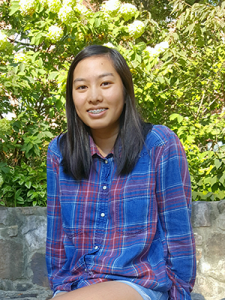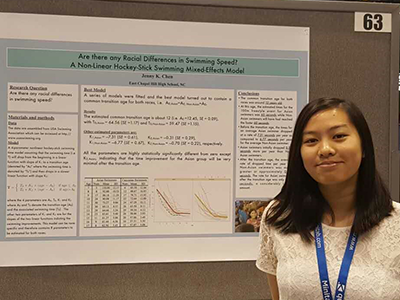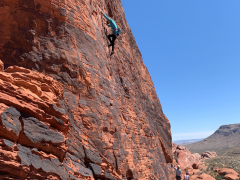Swimming Against the Tide with Statistics
January 5, 2017
 Jenny Chen needed to solve a problem in the pool.
Jenny Chen needed to solve a problem in the pool.
A competitive swimmer since age five, Jenny found that now at age 13, she was struggling to improve and surpass her teammates. “The plateau hit me like a freight train and caused doubt to obscure the path to my goals. I began to fear diving into a race instead of relishing it, and everything that used to ignite a fire in me began to work against me.”
Jenny’s search for a solution to her swimming goals lead her to a new love- statistics. She was not a stranger to statistics as her father is a longtime American Statistical Association (ASA) member, but statistics was not her favorite subject.
However, after taking AP Statistics as a high-school sophomore, Jenny decided that her answer may be found using statistical modeling. Jenny had been told there might be a racial difference regarding factors on strength, stamina and size. This raised a scientific question in her mind as to whether or not there really is a racial difference in swimming speeds.
Jenny used data from the USA Swimming Association and her own swim club teammates, ages 7-17. She performed the data analysis using R software and a lattice library to examine swim times and age. She developed a statistical non-linear mixed-effects model to create projections for Asian and Non-Asian swim times against their ages.
Examining the projections, she found that the onset of puberty around age 12 impacted both groups and their swim times with Asians declining and Non-Asians swimming faster. Jenny found proof to back up her findings in well-documented research on how puberty impacts racial groups differently. She stated, “Since Non-Asian swimmers usually become stronger and taller than the Asian swimmers earlier, it is evident that those advantages will work to their benefit.”
Not only did she find answers, she presented her findings at ASA’s 2016 Joint Statistical Meetings (JSM) in her professional poster titled, “Is There Any Racial Difference in Swimming Speed? A Nonlinear Swim Hockey-Stick Mixed-Effects Model”.
“During my presentation, I met several professors near where I live. I even met some swim coaches who had the same question regarding racial differences in swimming!”
Through these experiences, she “learned that the statistical community is one that I would very much like to be a part of in the future” and plans to study either biostatistics or actuarial science in college. She continued swimming too. In 2016, she captained her East Varsity swim team to the North Carolina High School Athletics Association state swim tournament.
Solving her struggles in the pool led Jenny to discover her love of statistics. If you are curious about how things work, statistics is a career that will keep your curiosity piqued and your brain engaged.
Reviewed by the This is Statistics Team 07/2023
Related Posts

Hindsight Is 2023 for Former Statistics and Data Science Students
It’s back-to-school season! Gear up for the upcoming semester and consider diving into the captivating world of statistics and data science. Looking for diverse job opportunities that span across every industry? Look no further! With a variety of graduate programs and jobs, now is a great time for students to become data scientists and statisticians….

Elizabeth J. Kelly: “Statistics is for Adrenaline Junkies”
Elizabeth J. Kelly has always loved math, and as a professional statistician at Los Alamos National Laboratory (LANL) and a recreational rock climber, Elizabeth is an avid thrill-seeker who enjoys a challenge. “Math reminds me of climbing, including the need to focus, problem solve and persevere. I guess I ended up in statistics because I…

